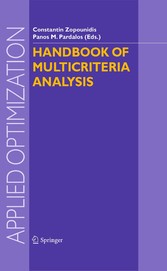Suchen und Finden
Service
Handbook of Multicriteria Analysis
Constantin Zopounidis, Panos M. Pardalos
Verlag Springer-Verlag, 2010
ISBN 9783540928287 , 472 Seiten
Format PDF, OL
Kopierschutz Wasserzeichen
"Chapter 9 Interactive Multiple Objective Programming Methods (p. 263-264)
Pekka Korhonen and Jyrki Wallenius
Abstract We provide an introduction to interactive methods in multiple objective programming1. Our discussion focuses on the principles to implement such methods. Our purpose is not to review existing procedures, but to provide some examples to illustrate the underlying main ideas. Furthermore, we discuss two available software systems developed to implement interactive methods.
9.1 Introduction
In most decision and planning situations a Decision Maker (DM) will have to consider multiple criteria implicitly or explicitly. The term Multiple Criteria Decision Making (MCDM)2 refers to decision and planning problems involving multiple (generally conflicting) criteria. For an MCDM-problem it is typical that no unique solution for the problem exists. The solution is determined by the preferences of the DM. Solving a Multiple Criteria Problem means that a DM will choose one “reasonable” alternative which pleases him/her most. The word “reasonable” is defined more precisely by using the terms efficiency or nondominance.
Solving an MCDM-problem requires a dialogue with the DM. The main idea is simple: the system generates reasonable solutions (alternatives), and the DM will make choices. The DM’s choices are used by the algorithm to generate more solutions until the DM will reach the solution that pleases him/her most. Helping DMs deal with multiple criteria decision and planning problems has been the subject of intense studies since the beginning of the 1970’s (see, e.g., [8, 14, 20, 50, 65]),but many theoretical concepts were defined much earlier (see, e.g., [31, 48]).
In the 1970’s, the research focused on the theory of multiple objective mathematical programming and the development of procedures and algorithms for solving such problems. Many ideas originated from mathematical programming. The algorithms were programmed for mainframe computers and were used mainly for illustrative purposes.
During the 1980’s, a clear shift towards multiple criteria decision support occurred. Accordingly, more research focused on the user interface, on the behavioural aspects of decision-making, and on supporting the entire decision-making process from problem structuring to solution implementation. Several Multiple Criteria Decision Making Support Systems (MCDSS) were developed where a graphical presentation was an essential part of the system (see, e.g., [2, 6, 7, 29, 33, 35, 43, 44]). Some articles were also published where the behavioural realism of the MCDSSs was critically evaluated."



